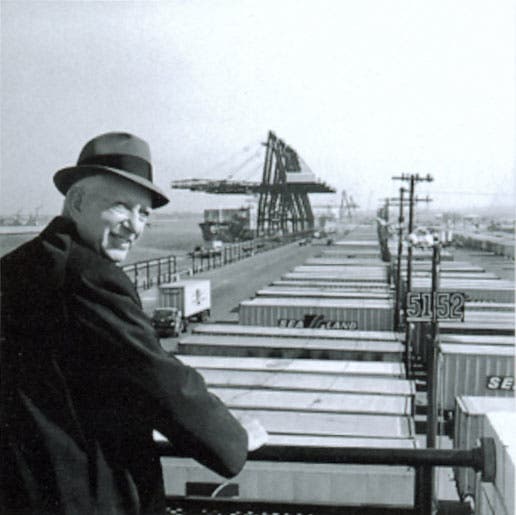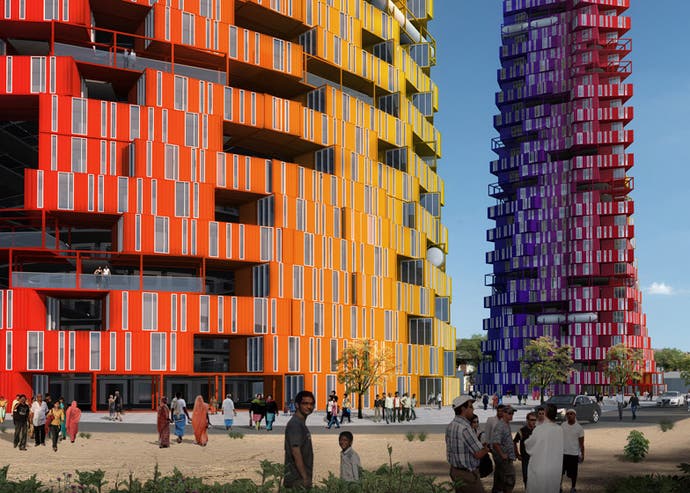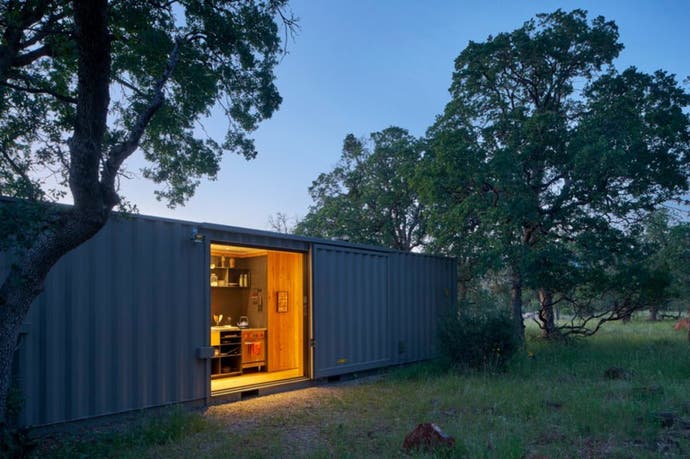Someone should make a game about: Shipping containers
A port we'd like to see.
Bleary eyed, I tore open my sachet of Quaker Oats, dumped it into a bowl, popped some milk in, and set the microwave to whirr for two minutes. This cost me. Usually it's a bit of bran, cold milk, and it's wolfed down in T-minus three minutes, give or take four. I hadn't factored in the other variables and I missed my bus into work. No way was I waking up earlier, no deal.
A revelation hit me the next morning. I dried my hair while my porridge was rotating in the background, which bought me more time to scoff the blonde magma. Normally I'd separate the two - a foolish decision in hindsight. This sweet symphony of white noise and heat meant I caught my bus on time, and as each regular shuffled on at their usual stops and took up their positions, it made me question their morning routines. Were they chasing efficiency too?

Enter logistics hall-of-famer and the father of containerization Malcom McLean. Back in the 1930's he'd parked his truck dockside and watched in growing disbelief as workers laboriously wheeled goods over to the side of a ship, attached them to slings, and precariously hoisted them into designated spots. Frustration led to a flash of inspiration: let's just bung all this stuff in containers and have trucks slide them onto ships.
Sheets of corrugated steel, that's all shipping containers are, really. Built as vessels for storing things and transporting them across the sea. Yet they've collectively scrunched the world up, and given us the ability to stretch our arms across entire continents to pluck something valuable right from its source.
And it's only when you glance at the likes of this stunning visualisation of the global shipping trade by Kiln that their impact is put into perspective.
Look at it! It's like we're hunched over with our hands clasping our knees, peering at a colony of ants tending to their nest. Switch to another map view and the containers morph into spiders, instead, and it's as if in our hunger for parts, for food, and for clothing we've spun a silken web over the ocean to feed our economy.

Shipping containers work tirelessly to keep global trade churning, and I can't help but humanise these steel boxes as unsung heroes hauling our stuff day in, day out. You could even say I feel for them a little bit, but comfort can be taken from the kinship they share between each other. No matter where they're from, they all speak the same language, and they all slot together. When a crane thunks one container on top of another, I like to think there's a special metallic twang which resonates throughout the hold communicating each new arrival, which is then met by quiet approval as the sound dissipates; a wordless embrace of sorts. Without one another, there is no trade, after all.
Eventually, clock hands meet and a bell chimes. And all those containers deemed a little too rusty, or a touch rattley are separated from the pack by the same cranes that lifted them countless times in the past (Pixar, call me?). They are retired now, but ultimately freed from the cycle, and perhaps it's this transition which has the most game-like promise.
Efficiency gives way to another form of efficiency, and it's one where their contents are no longer goods, but guests, or even occupants. They might be used as building blocks for a skyscraper, like the one proposed by CRG Architects, or the remarkable concept by architects Mouaz Abouzaid, Bassel Omara, and Ahmed Hammad, which would provide micro-homes for those living in Cairo's cemeteries.


They've hit the big time too. Qatar's 2022 World Cup Stadium is being built using modified shipping containers in the hopes it can be disassembled and reformed after the event has come to a close. Their straightforward nature encourages sustainable building and their history reflects our modern society where we're forever on the move. They challenge the idea of traditional urban design, so much so, projects aren't necessarily ticked off anymore, but bend and swivel to the community's wants or needs.
It doesn't take much nowadays to spot a shipping container complex that's sprung up somewhere you're familiar with - "wait, when did that get here?" Now they've developed a habit of popping up in the centre of towns and cities, their industrial aesthetic often at odds with the surrounding architecture. Pop-up swimming pools, restaurants, boutiques, you name it, they'll weasel their way into an unused, or unwanted space and deliver a guerilla service. This often leads to a greater sense of community too, as more modified containers can easily snap onto these small hotspots to further the fun, or in the case of Daiken-Met's container office building in Gifu, Japan, it can be dismantled, shifted and rebuilt elsewhere when it's time to move on.
I particularly love the idea of shipping container retreats, and I'd like to spend a stint in a unique holiday home planted somewhere off-grid one day. Not only is it the thought of escaping to somewhere idyllic - like this cabin constructed by Yamamar in the North Californian wilderness - there would also be a buzz to staying in something that looks as if it has washed ashore, and gives off the impression that nature's picked out this spot just for me. I imagine bidding farewell to my lodgings on the final day, and the tide reaching out to reclaim it the instant my back is turned.

Shipping containers are cubits of the global economy, ferried to-and-fro with the help of a well-oiled machine, and as we grow, the system becomes more intricate. Some highly sophisticated ports like Altenwerder are eerily quiet now. Gone are the yells of dockworkers, and the rumble of trucks, instead there's the calm lap of the ocean and the silent blinking of the IT system's lights.
As strides are taken in the march towards greater efficiency, more containers will tumble out of the system and appear in unexpected places, serving as a reflection of our society and a constant reminder to build a sustainable future.


